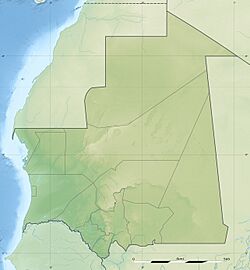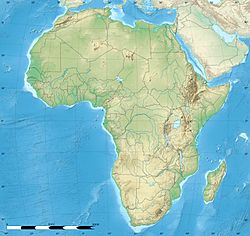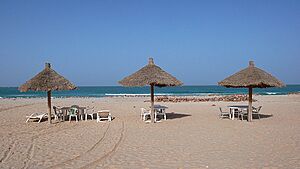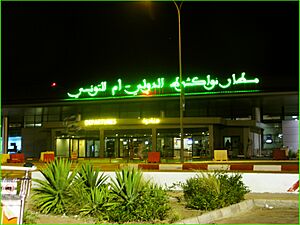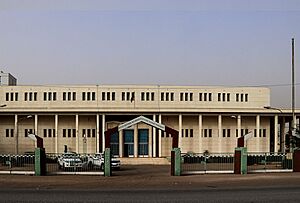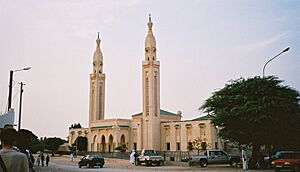Nouakchott facts for kids
Quick facts for kids
Nouakchott
|
|
|---|---|
|
From the top to bottom-right, View of the City, Saudi Mosque, Société Nationale Industrielle et Minière Tower, Presidential Palace, Avenue Général de Gaulle
City view of Nouakchott
|
|
| Country | |
| Wilaya |
|
| Subdivision |
Nine communes
Arafat
Dar Naïm El Mina Ksar Riyad Sebkha Tevragh Zeina Teyarett Toujounine |
| Government | |
| • Body | Regional Council of Nouakchott |
| Area | |
| • Total | 1,000 km2 (400 sq mi) |
| Elevation | 7 m (23 ft) |
| Population
(2019 census)
|
|
| • Total | 1,195,600 |
| • Density | 1,200/km2 (3,000/sq mi) |
| Time zone | UTC+00:00 (Greenwich Mean Time) |
| • Summer (DST) | (Not Observed) |
Nouakchott is the capital and largest city of Mauritania. It is located in the southwestern part of the country. This city is one of the biggest in the Sahara Desert. It is also the main center for government and business in Mauritania.
Nouakchott was once a small village by the coast. It was chosen to be the capital when Mauritania became a new country. Building started in 1958. The city was first planned for only 15,000 people.
However, its population grew a lot in the 1970s. Many Mauritanians moved there because of drought and the desert growing. A lot of new people settled in crowded areas. By the mid-1980s, Nouakchott had between 400,000 and 500,000 people.
As of 2019, the city had almost 1.2 million people. It is the heart of Mauritania's economy. It has a deepwater port and an international airport. The city is also home to the University of Nouakchott Al Aasriya and other learning centers.
Contents
History of Nouakchott
Not long ago, Nouakchott was a small fishing village. It was a fortified village (ksar) before French rule and during it. When Mauritania was getting ready for independence, it needed a capital city.
The area where Nouakchott is now was chosen by Moktar Ould Daddah. He was the first President of Mauritania. He wanted the new capital to show that Mauritania was modern and united. This meant not choosing an old city.
The village was picked because it was in the middle of Saint-Louis, Senegal and Nouadhibou. It also helped avoid problems between different groups of people.
Building started in March 1958. The goal was to make the village big enough for 15,000 people. The main parts were finished by November 28, 1960, when France gave Mauritania independence. The city was planned without expecting much business activity.
Nouakchott's main business area was designed with wide streets. A new area called Cinquième Quartier (Fifth District) grew quickly. It became a large outdoor market and living area. By the 1960s, the city had its own local government. By the 1970s, these new areas became more important than the old village. They held government buildings and state businesses.
The city was attacked twice in 1976 by the Polisario Front. This happened during the Western Sahara conflict. However, the attacks caused little damage. The city has grown very fast since the 1970s. This was mainly due to the North African drought. Hundreds of thousands of people moved there looking for a better life.
Official counts showed 134,000 people in 1977 and 393,325 in 1988. These numbers were likely lower than the real population. Today, the population is thought to be at least one-third of Mauritania's total. The 2013 count showed 958,399 people.
Geography and Landscape

Nouakchott is on the Atlantic coast, next to the Sahara Desert. Most of the coast is empty and can flood. This is except for the Friendship Port and a small fishing port. The coastline has shifting sandbanks and sandy beaches. There are also areas of quicksand near the harbor.
Nouakchott is mostly flat. Some parts of the city are even below sea level. Sand dunes from the east are a daily problem, as they keep moving towards the city. People have tried to protect certain areas from the sand. Because the city grew so fast, it is very spread out. Most buildings are only one story high.
The city is built around a big street called Avenue Gamal Abdel Nasser. This street has many trees and runs through the city center. It divides the city into two parts. The northern part has homes. The other part has the old city area (medina) and the kebbe. The kebbe is a shanty town that grew because people moved from other areas due to the desert.
Other main streets are named after important Mauritanian or international people from the 1960s. Examples are Avenue Charles de Gaulle and Avenue Kennedy.
The kebbe has buildings made of cement. They are often built quickly to look permanent. This helps avoid them being torn down by authorities. In 1999, it was thought that more than half of the city's people lived in tents and shacks. These were used for living and for businesses.
The city is divided into nine areas called arrondissements. These are Teyarett, Ksar, Tevragh-Zeïna, Toujounine, Sebkha, El Mina, Dar-Naïm, Arafat, and Riad. The Sebkha area has a large shopping district.
Climate and Weather
Nouakchott has a hot desert climate. This means it has hot temperatures all year. However, winter nights can be cool. Because the city is by the ocean, it is not as hot as other desert cities. Still, some days can be extremely hot.
Average high temperatures are around 33°C (91°F). Average low temperatures can range from 25°C (77°F) in the fall to 13°C (55°F) in the winter. The coldest winter nights can drop to 10°C (50°F). The city gets about 95 millimeters (3.7 inches) of rain each year.
| Climate data for Nouakchott (1981–2010, extremes 1934–2012) | |||||||||||||
|---|---|---|---|---|---|---|---|---|---|---|---|---|---|
| Month | Jan | Feb | Mar | Apr | May | Jun | Jul | Aug | Sep | Oct | Nov | Dec | Year |
| Record high °C (°F) | 39.9 (103.8) |
41.7 (107.1) |
44.0 (111.2) |
47.5 (117.5) |
47.0 (116.6) |
47.2 (117.0) |
47.5 (117.5) |
45.1 (113.2) |
45.5 (113.9) |
44.5 (112.1) |
42.3 (108.1) |
39.6 (103.3) |
47.5 (117.5) |
| Mean daily maximum °C (°F) | 29.1 (84.4) |
30.8 (87.4) |
33.5 (92.3) |
34.8 (94.6) |
34.3 (93.7) |
34.7 (94.5) |
32.4 (90.3) |
33.0 (91.4) |
36.1 (97.0) |
36.7 (98.1) |
34.0 (93.2) |
31.0 (87.8) |
33.4 (92.1) |
| Daily mean °C (°F) | 21.5 (70.7) |
23.0 (73.4) |
24.2 (75.6) |
24.3 (75.7) |
25.8 (78.4) |
26.7 (80.1) |
27.3 (81.1) |
28.4 (83.1) |
29.6 (85.3) |
28.8 (83.8) |
25.8 (78.4) |
22.8 (73.0) |
25.7 (78.3) |
| Mean daily minimum °C (°F) | 14.5 (58.1) |
16.4 (61.5) |
18.2 (64.8) |
19.1 (66.4) |
20.7 (69.3) |
22.8 (73.0) |
24.3 (75.7) |
25.4 (77.7) |
25.8 (78.4) |
23.8 (74.8) |
19.7 (67.5) |
16.9 (62.4) |
20.6 (69.1) |
| Record low °C (°F) | 3.9 (39.0) |
7.0 (44.6) |
5.0 (41.0) |
10.0 (50.0) |
13.0 (55.4) |
15.7 (60.3) |
15.0 (59.0) |
16.1 (61.0) |
17.0 (62.6) |
13.0 (55.4) |
9.3 (48.7) |
5.0 (41.0) |
3.9 (39.0) |
| Average precipitation mm (inches) | 0.7 (0.03) |
1.5 (0.06) |
0.2 (0.01) |
0.1 (0.00) |
0.3 (0.01) |
1.9 (0.07) |
6.3 (0.25) |
36.8 (1.45) |
36.3 (1.43) |
6.3 (0.25) |
2.0 (0.08) |
2.8 (0.11) |
95.2 (3.75) |
| Average precipitation days (≥ 1.0 mm) | 0.2 | 0.3 | 0.0 | 0.0 | 0.0 | 0.3 | 0.8 | 2.6 | 3.0 | 0.7 | 0.2 | 0.3 | 8.3 |
| Average relative humidity (%) | 36 | 39 | 43 | 49 | 54 | 60 | 70 | 72 | 69 | 55 | 44 | 35 | 52 |
| Mean monthly sunshine hours | 232.5 | 220.4 | 260.4 | 270.0 | 282.1 | 240.0 | 238.7 | 254.2 | 228.0 | 260.4 | 243.0 | 217.0 | 2,946.7 |
| Mean daily sunshine hours | 7.5 | 7.8 | 8.4 | 9.0 | 9.1 | 8.0 | 7.7 | 8.2 | 7.6 | 8.4 | 8.1 | 7.0 | 8.1 |
| Source: Deutscher Wetterdienst | |||||||||||||
Climate Change and the Future
A study in 2019 looked at how Nouakchott's climate might change. It suggested that by 2050, Nouakchott's weather could be like Khartoum's is today. This means the yearly temperature might go up by about 2.3°C (4.1°F).
Sustainable Energy Efforts
Nouakchott's need for electricity was expected to grow a lot. To help with this, the Sheikh Zayed solar power plant was built in 2012. It is considered the largest solar power plant in Africa. The desert climate can cause dust to build up on solar panels. This dust can make them less efficient.
Population Growth
| Historical population | ||
|---|---|---|
| Year | Pop. | ±% |
| 1961 | 5,807 | — |
| 1965 | 15,000 | +158.3% |
| 1970 | 25,000 | +66.7% |
| 1977 | 134,704 | +438.8% |
| 1981 | 232,000 | +72.2% |
| 1988 | 393,325 | +69.5% |
| 2000 | 558,195 | +41.9% |
| 2013 | 958,399 | +71.7% |
| 2019 | 1,195,600 | +24.7% |
In 1969, Nouakchott had only 20,000 people. It is hard to know the exact population today. This is because some people are nomadic. They set up tents in good spots and then move when they need to. Some guesses put the 2008 population at over 2 million. The 2013 count said the city had 958,399 people.
Improving Living Conditions
In 2013, reports said that "slums have been replaced by social dwellings for the poorest." The World Bank said this plan worked well. It gave 181,035 people in former slum areas better services. By 2024, the population is about 1.6 million people.
Economy and Jobs
Nouakchott is the main center for Mauritania's economy. In 1999, three-quarters of all service businesses were in the city. Also, 90% of the city's business activity was informal. This means it was not officially recorded. Some people in the city have more than one home. They keep strong ties to their home regions and sometimes go back to work there.
Transportation in Nouakchott
Nouakchott has a deepwater port built by China. It opened in 1986. It was made to handle 500,000 tons of cargo each year. But by 2009, it was handling 1,500,000 tons. In 2009, China agreed to invest $282 million to make the main quay longer. As of 2011, the World Bank was looking into funding a new shipping container area at the port.
Air travel is handled by Nouakchott–Oumtounsy International Airport. This airport opened in June 2016. It replaced the older Nouakchott International Airport.
The Cairo–Dakar Highway section from Nouakchott to Nouadhibou was paved in 2004. The section from Nouakchott to Rosso was paved even before Mauritania became independent. A 1,100-kilometer (680 mi) road called Route de l'Espoir (Road of Hope) connects the city to Néma. This road goes through Boutilimit and Kiffa. Inside the city, there is public transport and a commuter system. Vehicles serve the main streets.
In July 2022, a tramway project was shown. There is no set date for when it will open.
Education and Learning
The city is home to the University of Nouakchott Al Aasriya. This is the main university in Mauritania. It opened in 1981. In 1995, it had 70 professors and 2,800 students. There are also many international schools, like the American School TLC International School.
Other places for higher education include:
- The Lebanese International University of Mauritania
- The National School of Administration
- The College of Science and Technology
- The Higher Scientific Institute
There are many primary and secondary schools. Some of the most well-known are the American International School of Nouakchott, the Lycée Français Théodore Monod, and TLC International School.
Culture and Attractions
Things to see in Nouakchott include the National Museum of Mauritania and the National Library. You can also visit the Port de Péche and the National Archives. The city has several markets, like the Marocaine market.
The beaches are also popular. One beach is used by fishing boats. You can buy fresh fish right at the Fish market there. Nouakchott is also a main place to buy Saharan meteorites.
Places of Worship
Most places of worship in Nouakchott are Muslim mosques. Examples include the Saudi Mosque and the Sudanese Embassy Mosque.
There are also Christian churches and temples. These include the Roman Catholic Diocese of Nouakchott (Catholic Church), Protestant churches, and Evangelical Churches.
Sports in the City
Nouakchott is home to ten of the fourteen teams in Mauritania's top football league, the Super D1. These teams include:
- ACS Ksar
- AS Douanes
- AS Garde Nationale
- ASAC Concorde
- ASC Police
- ASC Tidjikja
- FC Gourel Sangue
- FC Tevragh-Zeina
- Kaedi FC
- Nouakchott Kings
There is also the Olympic Stadium near Bon Prix, which is a place for many sports activities.
Sister Cities
Nouakchott is connected with other cities around the world. These are called sister cities:
See also
 In Spanish: Nuakchot para niños
In Spanish: Nuakchot para niños







